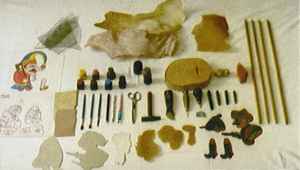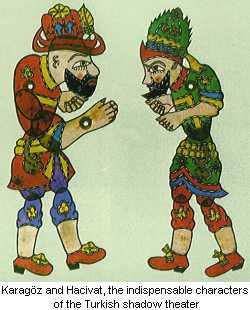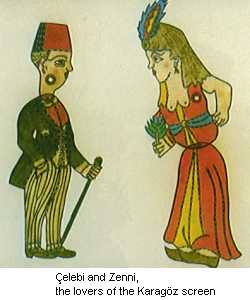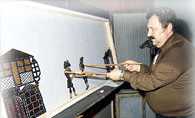Turkey's National Shadow Theater
Karagöz
 (Turkish:
Black Eyes, or Gypsy), type of Turkish shadow play, named for its stock
hero, Karagöz. The comically plays are improvised from scenarios for local audiences in
private homes, coffee shops, public squares, and innyards. The
Karagöz play apparently was highly developed in Turkey by the 16th century and was
adapted in Greece and North Africa. In the 20th century, however, Karagöz plays have lost
some popularity to cinema and other forms of entertainment. Their performance in Turkey
has been mostly confined to the Muslim holy month of Ramadan. (Turkish:
Black Eyes, or Gypsy), type of Turkish shadow play, named for its stock
hero, Karagöz. The comically plays are improvised from scenarios for local audiences in
private homes, coffee shops, public squares, and innyards. The
Karagöz play apparently was highly developed in Turkey by the 16th century and was
adapted in Greece and North Africa. In the 20th century, however, Karagöz plays have lost
some popularity to cinema and other forms of entertainment. Their performance in Turkey
has been mostly confined to the Muslim holy month of Ramadan.
Although the origin of the Turkish shadow play is still a subject of speculation today,
there is high probability that this form arose in Egypt. When the Ottoman Sultan
Selim I conquered Egypt in 1517, the Mameluke Sultan Tumanbay
was executed by hanging. In a shadow-show dramatization of the hanging in a palace on the
Nile, the puppeteer deliberately had the rope snap in two on the first attempt, to the
great amusement of Selim, who showered the puppeteer with gifts and took him along on his
return to Istanbul.
In the early seventeenth century, Egyptian shadow puppeteers were also brought from
Egypt to perform at the wedding of one of the Sultan's brothers. Exhibiting their skills
later in various parts of the Empire, these puppeteers laid the foundations of the Turkish
shadow theater.
 The
character of Karagöz is a good-natured underdog who usually gets his
turban knocked off in fights. He exchanges satiric and vulgar repartee with his friend Hacivat,
a pompous Turk with an affected accent, and with other stock characters, such as a newly
rich peasant, a conniving dervish, and a Jewish merchant. In Turkey, the Karagöz (a
character, Black-eye) theatre was the prevalent form of shadow play. This art
apparently came from China or perhaps from Southeast Asia, as the French term ombres
chinoises indeed hints, though the prevailing element of the grotesque was probably
inherited from ancient Greece by way of Byzantium. The Karagöz was well known in Turkey
during the 16th century but was so fully developed that it must have been introduced much
earlier, and it quickly spread from Syria to North Africa and the Greek islands. Its
performers were in great demand at the sultan's court as well as elsewhere, and they soon
organized their own guild. Since only the framework of the play was sketched in writing,
there was scope for a great deal of impromptu wit, and Karagöz shows, like the ortaoyunu,
were inevitably satirical. But with the coming of motion pictures the Karagöz declined,
and performances are now mostly confined to the month of Ramadan. The
character of Karagöz is a good-natured underdog who usually gets his
turban knocked off in fights. He exchanges satiric and vulgar repartee with his friend Hacivat,
a pompous Turk with an affected accent, and with other stock characters, such as a newly
rich peasant, a conniving dervish, and a Jewish merchant. In Turkey, the Karagöz (a
character, Black-eye) theatre was the prevalent form of shadow play. This art
apparently came from China or perhaps from Southeast Asia, as the French term ombres
chinoises indeed hints, though the prevailing element of the grotesque was probably
inherited from ancient Greece by way of Byzantium. The Karagöz was well known in Turkey
during the 16th century but was so fully developed that it must have been introduced much
earlier, and it quickly spread from Syria to North Africa and the Greek islands. Its
performers were in great demand at the sultan's court as well as elsewhere, and they soon
organized their own guild. Since only the framework of the play was sketched in writing,
there was scope for a great deal of impromptu wit, and Karagöz shows, like the ortaoyunu,
were inevitably satirical. But with the coming of motion pictures the Karagöz declined,
and performances are now mostly confined to the month of Ramadan.
In the traditional performance of the Karagöz, the stage is separated
from the audience by a frame holding a sheet; the latter has shrunk over the years from
about six by 7˝ feet (1.8 by 2.3 metres) to about three by two feet (0.9 by 0.6 metres).
The puppets, which are flat and made of leather, are controlled by the puppeteers with
rods and are placed behind the screen. An oil lamp is then placed still farther back so
that it will throw the puppets' shadows onto the screen.
A standard shadow play has four main elements:
- an introduction in which a preparatory scene is first shown on the previously. empty
screen and then removed to the raw strains of a reed flute, followed by Hacivat's
recitation, to the beat of a tambourine, of a mystico-philosophical gazel, and ending with
a squabble between Hacivat and Karagöz, who has in the meantime joined
Hacivat on the screen;
- a dialogue between Hacivat and Karagöz, the major characters;
- the main play itself; and
- a short closing in which Hacivat accuses Karagöz of having destroyed the screen and
goes off to inform the owner while Karagöz begs the spectators forgiveness for all the
slips of the tongue committed by the characters.
 The introduction is fairly stereotyped and consists of an argument and
usually a quarrel between Karagöz and Hacivat, the two most common characters. The former
is a simple, commonsense fellow, while the latter is more formal and polished, if shallow
and pedantic. The dialogue between the two varies with the occasion but always contains
impromptu repartee, though most puppet masters have at least 28 different plots in stock -
a different one for each night of Ramadan. Some are historical, many ribald, but all are
popular entertainment. Additional characters or animals may be introduced, calling for
great skill on the part of the puppet master and his assistant in manipulating several
simultaneously, as well as in reciting the text in changing tones and playing music. Some
have one or two musicians to help. The introduction is fairly stereotyped and consists of an argument and
usually a quarrel between Karagöz and Hacivat, the two most common characters. The former
is a simple, commonsense fellow, while the latter is more formal and polished, if shallow
and pedantic. The dialogue between the two varies with the occasion but always contains
impromptu repartee, though most puppet masters have at least 28 different plots in stock -
a different one for each night of Ramadan. Some are historical, many ribald, but all are
popular entertainment. Additional characters or animals may be introduced, calling for
great skill on the part of the puppet master and his assistant in manipulating several
simultaneously, as well as in reciting the text in changing tones and playing music. Some
have one or two musicians to help.
In later periods there were efforts to modernize Karagöz. In the nineteenth century,
for example, Ahmet Mithat Efendi replaced the curtain with frosted glass
and increased the size of the puppets. Kâtip Salih, using electric lamps
in place of candles, adapted the texts of French comedies in his Karagöz company which
flourished in the 1910's. Among the innovations, however, those involving the texts have
been the most important. Karagöz sustained its popularity over the centuries by
portraying current events, thus, when the old texts are employed today, they arouse little
interest.
Mimicry and caricature, while essential to both the meddah and
the ortaoyunu, are technically more developed in the shadow play. Here entire
productions are based on a comedy of manners or of character. In addition to the stock
characters from various ethnic groups, there is, for example, the drug addict who wraps
his narcotic in dissolving gum before the fast begins so as not to sin, the light-headed
Turk (he who eats his inheritance) who is a prodigal and a debauchee, the highway
robber, the stutterer, and the policeman.
 Karagöz
is the most frequently performed but not the sole type of shadow play in Muslim countries.
In Egypt a shadow theatre is known to have existed as early as the 13th century, long
before records of Karagöz shows were kept in Turkey. A physician, Muhammad ibn
Daniyal, wrote three shadow plays that have survived. They were performed in the
13th century and display humour and satire and the lampooning of match-making and
marriage. These plays also introduce a parade of popular contemporary characters, many of
whom earn their living in shady or amusing trades. A positively phallic element is as
evident here as it is in the Karagöz. Karagöz
is the most frequently performed but not the sole type of shadow play in Muslim countries.
In Egypt a shadow theatre is known to have existed as early as the 13th century, long
before records of Karagöz shows were kept in Turkey. A physician, Muhammad ibn
Daniyal, wrote three shadow plays that have survived. They were performed in the
13th century and display humour and satire and the lampooning of match-making and
marriage. These plays also introduce a parade of popular contemporary characters, many of
whom earn their living in shady or amusing trades. A positively phallic element is as
evident here as it is in the Karagöz.
|